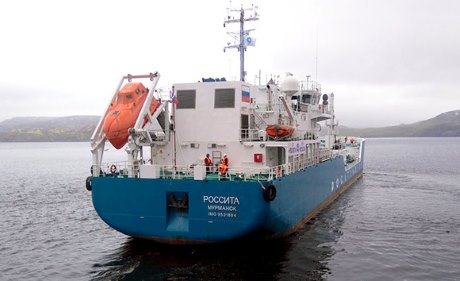The first shipment of used nuclear fuel assemblies from Russian nuclear submarines has left the former base of the Russian Northern Fleet at Andreeva Bay. Over 20,000 used fuel assemblies are to be retrieved, packed and removed from the site under an international initiative financed by the Nuclear Window of the Northern Dimension Environmental Partnership (NDEP), which is administered by the European Bank for Reconstruction and Development (EBRD).
 |
| The first shipment of used fuel leaves Andreeva Bay on board the Rossita (image: EBRD) |
Andreeva Bay, in the Murmansk region of north-western Russia, was a coastal technical support base for the Soviet Union's Northern Fleet. During the Cold War, when the fleet's nuclear-powered submarines were refuelled their used fuel was transferred via ship to Andreeva Bay to be stored in an onsite pond storage facility. It was later transferred to dry storage units at the site. Over the years the condition of the dry storage units has deteriorated, and the site poses a serious environmental risk. Fuel from 100 reactors has been stored at the site.
Andreeva Bay was closed as a naval base in 1992, after the dissolution of the Soviet Union, and transferred to civilian authorities in 1993. It is now managed by Russian state atomic energy corporation Rosatom. Norway and Russia in 1992 signed a bilateral agreement to address the nuclear legacy issues of the former Northern Fleet and the decommissioning of the nuclear submarines. The safe management of the resulting nuclear and radiological material has continued to be an international effort.
The strategy for removing used fuel from the dry storage units was developed from 2002 by Russia and international experts, with funding from the UK. The multi-step removal procedure included building an enclosure of the dry storage units, some of which are damaged and leaking. The fuel is retrieved by machine, under shielded conditions, and transferred to new canisters which are then moved to specialised 40-tonne casks for further transportation.
The casks are moved in a specially designed transport vehicle to a holding area known as the accumulation pad. A purpose-built 50-tonne trolley moves the casks from the accumulation pad to the newly built pier where a specially designed crane loads them onto the Rossita radioactive waste transport ship, which was built and financed by Italy. The casks will be shipped to Murmansk from where they will be transported by rail to their final destination, the Mayak reprocessing plant in Chelyabinsk, near the Ural Mountains.
The fuel removal process is being carried out SevRAO, the northern centre of Rosatom's Moscow-based commercial back-end radioactive waste and decommissioning services subsidiary RosRAO.
The NDEP was established in 2002 to provide technical assistance for environmental projects in the north-west region of Russia. Its support fund, administered by the EBRD, was set up in 2002, with support from the European Union and Belarus, Belgium, Canada, Denmark, Finland, France, Germany, the Netherlands, Norway, Russia, Sweden and the UK. The Nuclear Window was set up in 2003 to provide funding for projects to mitigate the legacy of the operation of the nuclear-powered ships and submarines of the Northern Fleet.
The work at Andreeva Bay has also been supported by bilateral contributions. A nuclear materials accountancy system and new canisters for used fuel assemblies were supplied by the EU. Norway built the decontamination facility, pier, roads and other supporting infrastructure. The UK funded the design and construction of used fuel management facilities. Italy provided facilities for radioactive waste management and constructed the Rossita, while Sweden supported development of the design for solid and liquid radioactive waste management. Russia is responsible the transportation and treatment of the used nuclear fuel at the Mayak facility.
Pierre Heilbronn, EBRD vice president for policy and partnership, said the Andreeva Bay project was a "truly remarkable example of international cooperation" on matters of global environmental importance. "It is particularly pleasing to see that nations put aside their differences to resolve such crucial issues as the legacy of the nuclear-powered fleet in the north of Russia," he said.
Researched and written
by World Nuclear News




_47120.jpg)
_23621.jpg)

_63865.jpg)





